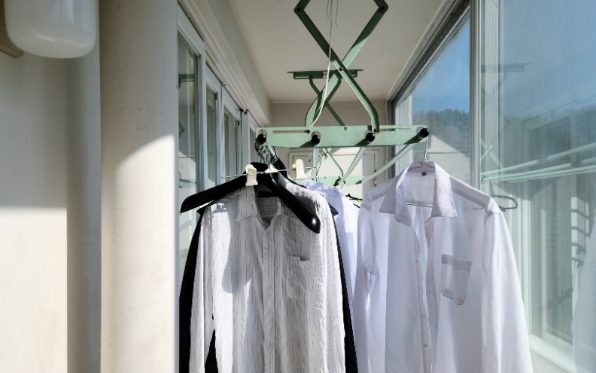Laundry drying is an essential household task, but the method used significantly impacts efficiency, convenience, and overall living space. Manual drying racks and clotheslines have been commonplace drying techniques for many years. However, automatic laundry racks are becoming a better option as home automation appliances become more popular. These clever solutions are popular for home automation due to their effectiveness, ease, and space optimisation.
Analyse the main distinctions between automated washing racks and conventional drying techniques, weighing the benefits and cons of each.
Efficiency and Drying Time
Traditional drying methods rely on environmental conditions, such as sunlight and airflow, to dry clothes. This approach can be inefficient, particularly in humid or rainy seasons when drying time increases significantly. Clotheslines and static laundry racks require manual intervention, and drying times are unpredictable.
In contrast, an automatic laundry rack offers faster and more consistent drying. Many models integrate heating, UV sterilisation, and fan-assisted drying to speed up the process. Unlike traditional methods, which depend on weather conditions, an automatic laundry rack ensures clothes dry quickly and hygienically. This technology is particularly beneficial in urban areas with limited outdoor space, where natural drying is impractical.
Space Optimisation
Space is a major factor when comparing drying solutions. Traditional drying methods require dedicated space, whether indoors or outdoors. Clotheslines occupy large areas and may obstruct pathways, while manual laundry racks take up floor space that could be used for other purposes. Folding racks provide some flexibility but still require sufficient room for setup.
An automated laundry rack is designed for space efficiency. Most models are ceiling-mounted, retractable, or wall-mounted, allowing users to maximise floor space. These racks can be lowered when needed and retracted when not in use. This feature is beneficial in apartments and compact living spaces, where optimising available space is a priority. Unlike traditional drying solutions, automated racks do not contribute to clutter or inconvenience.
Convenience and User Experience
Traditional drying requires significant manual effort. Hanging clothes on a clothesline or placing them on a rack involves lifting, bending, and arranging items to ensure even drying. Users must also move drying racks based on sunlight availability, making the process time-consuming and inconvenient.
Automatic laundry racks eliminate much of the manual labour involved. Many models come with remote control operation, allowing users to adjust the rack’s height and drying settings effortlessly. Features such as automated lifting, temperature control, and built-in lighting add to the convenience. Elderly users or those with mobility issues benefit from the ease of use, as there is no need for excessive bending or lifting. Unlike traditional drying methods, an automatic laundry rack streamlines the process with minimal effort.
Weather Dependence and Reliability
Weather conditions are critical in traditional drying methods. Rain, humidity, and low temperatures significantly slow down the drying process and may result in damp, musty-smelling clothes. Clotheslines are also susceptible to dirt, dust, and pollution, which can affect cleanliness.
An automatic laundry rack removes the reliance on weather conditions. Indoor models allow users to dry clothes regardless of the season. Advanced models incorporate UV sterilisation, eliminating bacteria and odours, and ensuring clothes remain fresh and hygienic. This product makes automated drying a more reliable option for households that require consistent and effective drying solutions.
Durability and Maintenance
Traditional drying methods involve exposure to outdoor elements, which can lead to wear and tear over time. Clotheslines may sag, rust, or break, while manual drying racks can become unstable with frequent use. Wooden racks are prone to mould and moisture damage, requiring regular replacement.
Automatic laundry racks are built with durable materials such as stainless steel and aluminium, ensuring long-term performance. Many models are designed with corrosion-resistant coatings, making them suitable for indoor and outdoor use. While these racks may require occasional maintenance, they are generally more durable than traditional drying methods. Additionally, modern automated racks come with warranty coverage, offering users long-term value.
Energy Consumption and Cost
Traditional drying methods do not require electricity, making them an energy-efficient choice. However, the limitations in drying speed, space usage, and manual effort often outweigh the cost benefits. Additionally, relying on air drying in humid environments may result in damp clothes, leading to increased use of dehumidifiers or heaters.
An automatic laundry rack does require electricity, but many energy-efficient models use minimal power. The built-in heating and fan-assisted drying functions consume less energy than conventional dryers. Over time, the convenience and efficiency of an automated rack justify the initial investment. Users save time and effort while ensuring their clothes dry quickly and hygienically.
Conclusion
Automated laundry racks offer significant advantages over traditional drying methods in terms of efficiency, space optimisation, convenience, and reliability. Traditional methods are still economical, although they are labour-intensive and weather-dependent. An automatic laundry rack, on the other hand, offers a clever, practical, and easy-to-use solution that complements contemporary home automation products. Purchasing an automated drying system is a sensible and effective option for those wishing to enhance their laundry routine.
Contact Homino to discover how our household automation products can transform your daily routine.

